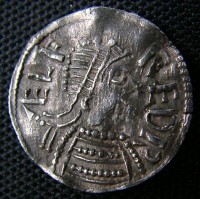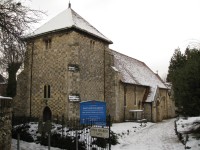 In a secret ten-hour mission, archaeologists exhumed the possible but very unlikely remains of Alfred the Great from an unmarked grave in the churchyard of St. Bartholomew’s in Winchester. This wasn’t so much an exploratory mission as a rescue operation. After the world-wide attention the discovery of Richard III’s parking lot burial received, church authorities were concerned that St. Bartholomew’s cemetery, where the putative bones of Alfred the Great were said to have been buried in the 19th century, might be targeted by grave robbers. The Parochial Church Council decided to opt for an ounce of prevention and commissioned a team to excavate the burial thought to be Alfred’s and store the remains in an undisclosed location.
In a secret ten-hour mission, archaeologists exhumed the possible but very unlikely remains of Alfred the Great from an unmarked grave in the churchyard of St. Bartholomew’s in Winchester. This wasn’t so much an exploratory mission as a rescue operation. After the world-wide attention the discovery of Richard III’s parking lot burial received, church authorities were concerned that St. Bartholomew’s cemetery, where the putative bones of Alfred the Great were said to have been buried in the 19th century, might be targeted by grave robbers. The Parochial Church Council decided to opt for an ounce of prevention and commissioned a team to excavate the burial thought to be Alfred’s and store the remains in an undisclosed location.
This is even longer of a shot than the Richard excavation. For one thing, Richard died just over 500 years ago. He was also buried in one place. Alfred died in 899, 1114 years ago, and his remains were moved repeatedly over the next thousand years. He was first interred in the Old Minster in Winchester. It’s believed that Alfred had commissioned the construction of a new, larger church where his remains and that of his dynastic successors would be buried, but the New Minster wasn’t finished until around 903 when his son Edward the Elder was king. The son had his father’s body moved from the old church to the new. After they died, Alfred’s wife Ealhswith, Edward the Elder and Edward’s children were also buried in the New Minster.
When the Normans conquered England, they built a new cathedral on the site of the old church and it rendered the New Minster obsolete. King Henry I commissioned a new New Minster be built north of Winchester in the suburb of Hyde. Hyde Abbey was far enough completed by 1110 that Alfred and his family were reburied there. The Abbey was demolished during the dissolution of the monasteries in 1539, but the graves were left untouched.
As with the Greyfriars church where Richard III was buried, the Hyde Abbey’s location was forgotten over the centuries. It was rediscovered when the county purchased the land for prison in 1788. The convicts building the prison began by clearing the rubble left by Henry VIII’s marauders. They dug deep pits in which to bury the larger pieces of masonry and one of those pits crossed paths with three royal graves in front of the former high altar. According to the prison warden who was interviewed by antiquarian Captain Howard a few years later, the convicts unearthed a large coffin thought to be Alfred’s. It was carved out of a single block of stone encased in lead. They broke up the coffin, buried the stone in the pit and sold the lead. The bones were scattered.
 In 1866 antiquarian John Mellor excavated the site and claimed to have found Alfred’s tomb intact. Those are the remains that were reinterred in the St. Bartholomew churchyard.
In 1866 antiquarian John Mellor excavated the site and claimed to have found Alfred’s tomb intact. Those are the remains that were reinterred in the St. Bartholomew churchyard.
So yeah, the odds of these bones being Alfred’s are vanishingly small. University of Winchester archaeologist Doctor Katie Tucker who led the exhumation hopes that the bones can at least be radiocarbon dated. If they turn out to date to the late 10th century, she thinks that will be evidence in favor of the remains belonging to Alfred or his immediate family because no other human remains from before Hyde Abbey’s construction in the 12th century were buried there, as far as we know.
I don’t think it’ll be evidence of anything because there’s hardly a well-established chain of evidence here. We can’t know for sure who was buried at Hyde, nor can we know for sure that the bones in this unmarked grave came from there. There’s little chance of DNA confirmation. Even if the bones did belong to Alfred, they’ve been moved so much and been exposed to who knows what conditions that DNA extraction will be a virtually insurmountable challenge. The remains of Alfred’s granddaughter Queen Eadgyth were discovered in the Cathedral of Magdeburg in Germany in 2008, but there were only 40 bones left and none of them were well-preserved enough to extract a viable DNA sample.
Anyway the process hasn’t even started yet. Winchester Diocesan spokesman Nick Edmonds:
“Understandably, there is widespread interest in this situation. For now we can’t say any more about the remains, their nature or whereabouts, but promise to keep people updated when there is something to tell.
Although no application has yet been made to carry out any scientific investigation, we do acknowledge that there is local interest in learning more about the remains found in this grave.”